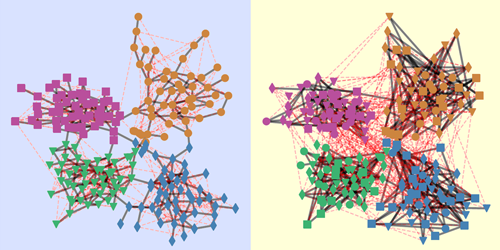Epidemic Spreading in Multilayer Networks
“We need to flatten the curve” became a common mantra during the COVID-19 crisis as governments sought to buy breathing space for overstretched health services. Some of those governments enacted policies designed to limit mixing within the population, hoping to reduce the peak number of people requiring care at the same time. Researchers at Indiana University Bloomington have now shown that, in some populations, this flattening can be achieved by altering the social groups that individuals belong to [1].
Siddharth Patwardhan, Varun Rao, and their colleagues modeled a population as a network consisting of multiple separate layers. Each person in the population appeared in every layer of the network, but often in different social circles. The researchers investigated how an epidemic that spreads through person-to-person interactions would play out under different degrees of correlation between the patterns of connectivity in the different layers.
To test their model, the researchers implemented a two-layer version of their network using data from Indiana University Bloomington. One layer of the network represented students’ enrollments in various classes; the other represented the same students’ housing arrangements. The team found greater social mixing when students’ accommodation arrangements had no link to the classes that they took, that is, the connections in the different layers were uncorrelated. This increased mixing led to a faster-spreading epidemic and an earlier, more intense infection peak. Dissimilarity between the makeup of social circles in the layers also made controlling the epidemic harder. For example, when using a random immunization strategy to achieve a given level of infection suppression, 8 times more students needed to be vaccinated when students’ housing assignments were different from their class membership than when they were the same.
–Marric Stephens
Marric Stephens is a Corresponding Editor for Physics Magazine based in Bristol, UK.
References
- S. Patwardhan et al., “Epidemic spreading in group-structured populations,” Phys. Rev. X 13, 041054 (2023).




